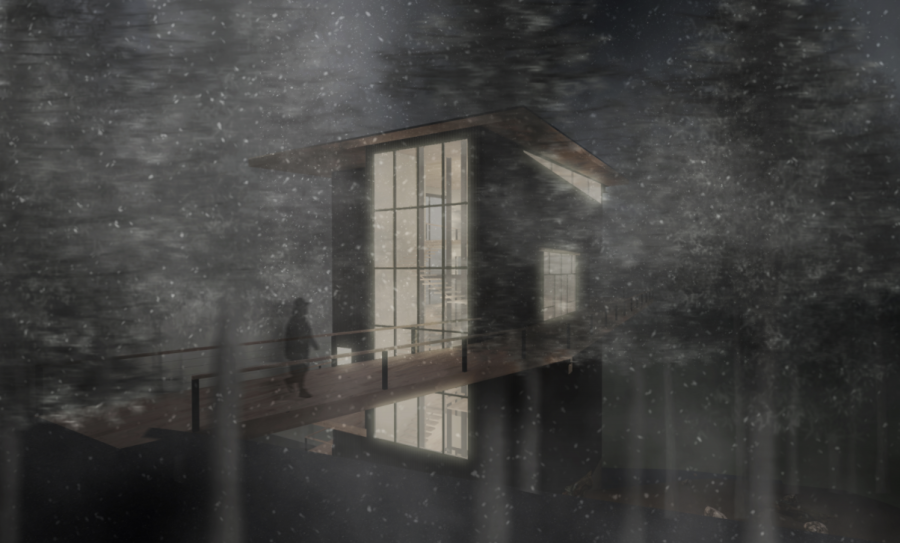Mount Lemmon is steep with its climate colder than Tucson at lower elevations and its landscape speckled with trees. It may not seem like the ideal place to construct a science learning center that is easily accessible to all. However, third-year architecture students accepted the challenge to compete for $5,000 in student prizes as part of the AGM Universal Design Award.
RELATED: UA CAPLA introduces new award with emphasis on universal design, inclusivity
Student recipients of the award were selected by a jury at the end of the fall 2020 semester. Individual awards included one $2,000 Honor Award, two $1,000 Merit Awards and several additional $200 innovation awards. This was the first time the competition was held and was the result of a collaborative effort between Container Controls Ascension Wheelchair Lifts, a subsidiary of AGM, and the University of Arizona College of Architecture, Planning and Landscape Architecture.
The challenge was assigned as the final project in architecture course ARC 301 Design Studio III: Integrations of Place taught by professors Eduardo Guerrero, Bill Mackey, Siri Beidler Trumble and Teresa Rosano. As part of the course, students experimented with themes of accessibility as applied to sites of increasing steepness. The design of the science learning center was the culmination of concepts learned in the course and was left open for the students to take specific inspiration from the environment.
Honors award recipient Jules Cervantes explained that for her project, entitled “Emerge,” she wanted to highlight the stargazing capable from Mount Lemmon.
“The reason it’s called Emerge is because I wanted it to be of the site of the trees and of the ground but draw you up and bring you up toward the sky,” Cervantes said.
Merit Award recipient Hunter Jinbo took a different approach with her project, exploring the trees that stud the summit of Mount Lemmon.
“Every level of my project views a different part of the tree,” Jinbo said. “So when you enter from the top, you just see the crown of the tree. And then as you move lower into the building and down the other floors, you kind of focus on the center part of the tree or the trunk. And then the roots of the trees.”
For both Jinbo and Cervantes, the development of these concepts required the implementation of universal design principles in order to make their creations accessible to all.
“I wanted it to feel really weightless so that you’re kind of in the sky,” Cervantes said. “So even if you can’t see, you can still kind of feel the breeze; you can feel the lightness of the deck.”
Jinbo described her process with an emphasis on equalizing the unique experiences her design has to offer.
“It’s a very vertical circulation with my project,” Jinbo said. “I had to think about, well, what experiences do I want them to see? Because obviously, they can look out the window, but maybe traveling through the floors is something I want to add another experience to. So I created this glass atrium with a glass elevator and everything just encased in glass, and the stairway is wrapped around the elevator so that everybody had this equal and shared experience.”
Designing for Mount Lemmon’s unique environment introduced a new terrain as well as environmental concerns. Cervantes’ design emphasized simplicity to minimize the destruction of the natural landscape.
“Anytime you build something, you destroy the trees, the landscape, the animals that live there,” Cervantes said. “So I tried to make it the smallest square footage it could be while still being really efficient.”
Ultimately, according to Jinbo, the project was a rewarding experience that pushed her to explore the depths of universal design. She said she also valued the input and recommendations from members of the jury Sherry Santee and Eric Bell, who are wheelchair-bound.
“Hearing from [Bell’s] perspective and all of his experiences with places he’s been to that he couldn’t ever enjoy because they just never thought about universal design, I think it’s important,” Jinbo said.
The awards provided recipients a means to get feedback on their projects from practicing architects in addition to a cash prize. Jinbo stated that, after what has been a difficult year during the pandemic, she is excited to put the money towards her tuition.
“It’s just kind of reassures me that how I’m thinking and the way I’m approaching things, I’m going in the right direction … all of that hard work paid off,” Jinbo said.
Follow Hillary Schiff on Twitter















